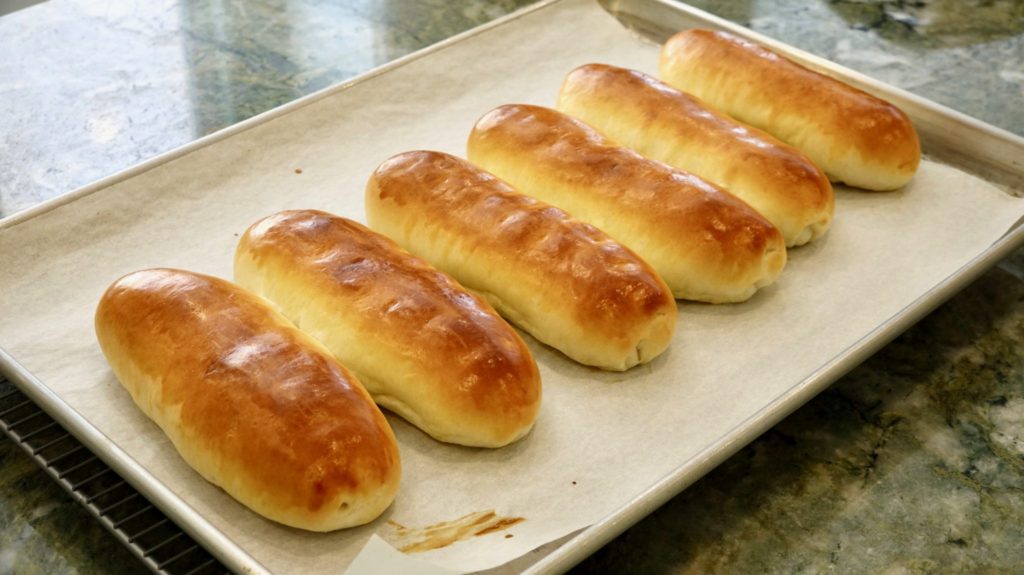Aburaage (油揚げ) is a key ingredient in many traditional Japanese dishes. These thin, deep-fried tofu pouches have a unique crispy but soft texture and subtle taste that make it ideal for soups like miso soup because it absorbs the delicious broth. It can also be used for inari sushi, oden, and stir fries. Discover how to make this protein-rich, vegetarian-friendly ingredient at home to use in your Japanese home-cooking!

What is Aburaage?
Aburaage, also known as usu-age, is a Japanese ingredient made from thinly sliced tofu that has been deep-fried until golden. This process creates a unique, pouched tofu with a crispy exterior and a soft, airy interior. The name “aburaage” literally translates to “deep-fried oil,” reflecting its cooking method. The tofu pockets are usually about 8 cm long and 4 cm wide.
Aburaage is very versatile in Japanese cuisine. It can be used as-is in various dishes like udon or soba noodles and hot pots, stuffed with ingredients like sushi rice to make inari sushi, or sliced and added to miso soup, stews, and stir-fries. The aburaage has quite a neutral flavor that readily absorbs other tastes, making it perfect to use in a variety of ways. It’s a protein-rich food that’s delicious and also well-suited for vegetarian and vegan recipes.
Since it’s such a versatile and common ingredient in Japanese cooking, it’s readily available in Japan and Japanese supermarkets outside of Japan. But this recipe is for anyone who can’t get access to it or just prefer to make things homemade.
Ingredients Required to Make Abraage
To make aburaage at home, you only need two simple ingredients:
Firm Tofu
This is the main ingredient. Choose a high-quality ‘momen’ (firm) tofu that can withstand the slicing and frying process without falling apart. Nowadays, you should be able to purchase tofu even from your local supermarkets. Otherwise you can find it in Asian or Japanese supermarkets. If you can’t buy tofu anywhere near you, then you can even make it yourself at home from scratch with this recipe using soybeans.
Vegetable Oil
A neutral-flavored oil with a high smoke point is essential for deep-frying. Canola, sunflower, or rice bran oil are good options.

Instructions to Make Aburaage
- Wrap the firm tofu in kitchen paper, place it on a tray, and leave it in the refrigerator overnight without covering it with plastic wrap and with something heavy on it to drain out the water.
- Cut the tofu into 1cm thin slices, place on a paper towel and leave for about 5 min to drain further.

- Pour frying oil into a frying pan until it is about 3cm above the bottom. Fry the tofu at about 150℃ for about 20 minutes, turning the tofu over, until it is plump, puffy and slightly coloured brown. Then remove from the oil and transfer it to a wire rack to drain off the excess oil. If you add too many pieces at once, the temperature of the oil will drop, so deep fry in 2-3 batches (depending on the size of the tofu) while keeping an eye on the condition.
- Increase the oil to a higher temperature of 180℃ and deep fry the tofu a second time. Fry for about a few minutes while turning them over with chopsticks. When it’s done, it will be nicely golden brown all over.

- Make sure to remove all the water from the tofu. This is crucial for successful aburaage preparation. Any left over moisture within the tofu can create holes or cracks during frying. Also, even at high temperatures, proper frying won’t occur if water remains.
- Make sure to regularly change the paper towels when absorbing the moisture from the tofu otherwise it won’t be able to dry out properly. This dehydration process is essential for creating perfectly fried aburaage.
How to Serve Aburaage
Aburaage is a versatile ingredient that you can use in many Japanese dishes:
Inari Sushi
For this sushi, the golden pouches of tofu (‘inari age’) are simmered in a sweet and savory sauce then stuffed with sushi rice. It has a unique texture and delicious flavour.

Kitsune Udon
This type of udon noodle dish features aburaage as the star topping. The fried tofu is simmered in a sweet soy sauce mixture and served atop a steaming bowl of udon noodles in hot broth.

Oden
This comforting winter hotpot is usually filled with aburaage which is often stuffed with mochi or fish paste. It adds a delicious touch to the simmered assortment.

Miso Soup
Add thin strips of aburaage to miso soup for a subtle sweetness and interesting texture that complements the umami-rich soup. Add wakame seaweed and green onions to make a classic miso soup.

How to Store Aburaage
Aburaage won’t last too long if refrigerated, it’ll remain fresh for just 3-4 days. But you can freeze it to extend its shelf life to 2-3 weeks. Freezing the aburaage is particularly beneficial for individuals living solo and small households who may struggle to consume larger quantities of tofu before it spoils, and even just saves you having to make it every so often. By freezing, you can reduce food waste and always have this versatile ingredient on hand for your Japanese cooking.
Simply wrap individual pieces of the prepared aburaage in plastic wrap and then place them in a freezer bag without overlapping them, removing as much air as possible. This method is convenient when you want to grill the thawed fried tofu as is.

You can also cut the fried tofu into easy-to-use pieces and place them in a freezer storage bag. Flatten it as much as possible, remove the air, and then close the bag. If you divide it into single servings, it will be easier to use when cooking.
To thaw frozen fried tofu, leave it in the refrigerator to thaw naturally.
FAQ
Q : What is the difference between usu-age and atsu-age?
A : Atsuage is thickly sliced tofu deep fried in oil whereas usu-age is thinly slice. Atsuage is not hollow inside, the outside has a crispy shell but the inside is soft tofu. Usu-age, on the other hand, is more like a pocket so it can be stuffed with other ingredients like mochi or sushi rice.
Aburaage are Japanese fried tofu pouches that are a staple in a variety of dishes. Learn how to make them at home with this easy-to-follow recipe!
Cook Time 25 minutes
Draining moisture 12 hours
Servings: 3 pieces
- ▢ 300 g firm tofu
- ▢ 50 ml vegetable oil for deep-frying
Wrap tofu with a paper kitchen towel, and place it on a wire rack prepping tray (like in the photos).
Leave the tofu covered in paper towel in the fridge overnight with some kind of weight on it and without covering it in any wrap.
The next day, remove the kitchen paper towel from the tofu.
Slice the tofu 1cm thick and leave it on a paper towel for about 5 minutes to drain any excess moisture further.
Pour deep-frying oil in a frying pan to about 2-3cm deep from the bottom of the frying pan.
Place the slices of tofu into the oil gently (try not to overcrowd, you may have to fry one at a time), and deep fry the tofu in 150 °C for about 20 minutes turning the tofu over, until it is plump, puffy and slightly coloured brown.
Remove from the oil and place it onto a wire rack to drain off excess oil.
Increase the deep frying oil temperature to 180 °C, and deep-fry the tofu slices a second time for a few minutes turning the tofu over.
When the tofu colour turns into nice golden brown, remove it from the oil onto a wire rack lined with a paper towel to drain the excess oil off.
Calories: 220kcal · Carbohydrates: 2g · Protein: 9g · Fat: 20g · Saturated Fat: 3g · Polyunsaturated Fat: 12g · Monounsaturated Fat: 5g · Trans Fat: 0.1g · Sodium: 4mg · Fiber: 1g · Sugar: 0.3g · Calcium: 125mg · Iron: 1mg
Course: Side Dish
Cuisine: Japanese
I want to see it! Tag @chopstickchronicles on social media!
The site and our mobile application may contain links to affiliate websites. We receive a small affiliate commission for any purchase made by you on the affiliate website using such links. Read our disclosure policy.











 English (US) ·
English (US) ·